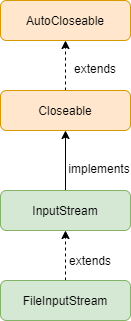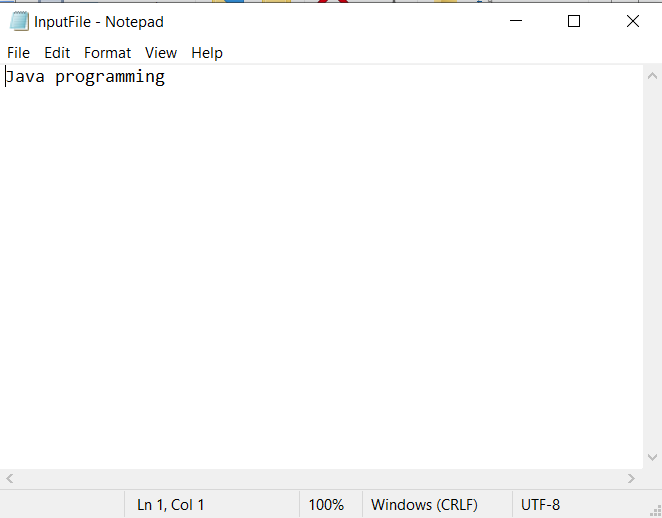Table of Contents
FileInputStream in Java
The FileInputStream class in Java extends the InputStream class. We use this class to read data in the form of bytes from a file. For example, we can use the FileInputStream to read an image, pdf file, audio, video.
Hierarchy

Constructors
The FileInputStream in Java has the below constructors:
| Constructor | Description |
|---|---|
| FileInputStream(File f) | Creates an input file stream to read data from the specified file. |
| FileInputStream(FileDescriptor fd) | Creates a file input stream to read the specified file descriptor |
| FileInputStream(String name) | Creates an input file stream to read data from a file specified with name |
Java FileInputStream methods
| Method | Description |
|---|---|
| int available() | Returns an estimate of the number of available bytes to read from the file |
| void close() | Closes the specified file |
| FileChannel getChannel() | Returns the unique FileChannel associated with the specified file |
| FileDescriptor getFD() | Returns the FileDescriptor associated to connect with the specified file |
| void mark(int readLimit) | Marks the current position in the input file |
| boolean markSupported() | Checks if the file supports mark() and reset() methods. |
| int read() | Reads a byte of data from the input stream |
| int read(byte[] b) | Reads upto b.length bytes of data from the file |
| int read(byte[] b, int off, int len) | Reads upto len bytes of data from the offset from the input stream |
| byte[] readAllBytes() | Reads all the remaining bytes of data from the input stream |
| byte[] readNBytes(int len) | Reads upto specified number of bytes from the input stream |
| int readNBytes(byte[] b, int off, int len) | Reads upto the specified number of bytes from the input stream |
| long skip(long n) | Skips and discards the n number of bytes from the input stream |
| void skipNBytes(long n) | Skips and discards exactly n number of bytes from the input stream. |
| long transferTo(OutputStream out) | Reads and writes all bytes of data from the InputStream to the OutputStream in the same order it reads |
Example: Read a single character from the file
The below example shows how to read a single character from the input file. We can use the read() method of the FileInputStream class which reads a single character at a time. To print it, we can typecast the value to char. Since the input file contains the content “Java programming”, it prints the first character “J” as the output.
import java.io.FileInputStream;
import java.io.FileNotFoundException;
import java.io.IOException;
public class ReadFile {
public static void main(String[] args) throws IOException {
try {
FileInputStream fi = new FileInputStream("InputFile.txt");
int a = fi.read();
System.out.println((char)a);
fi.close();
} catch (FileNotFoundException e) {
e.printStackTrace();
}
}
}
J
Content in the input file

Example: Read all characters from the file
In the below example, we are reading all characters from the input file using the read() method. Every time we call the read() method, it reads a single character. Hence using the while loop, we can read the data until this method returns -1 which is the end of the file.
import java.io.FileInputStream;
import java.io.FileNotFoundException;
import java.io.IOException;
public class ReadFile {
public static void main(String[] args) throws IOException {
try {
FileInputStream fi = new FileInputStream("InputFile.txt");
int a = 0;
while((a=fi.read()) != -1)
System.out.print((char)a);
fi.close();
} catch (FileNotFoundException e) {
e.printStackTrace();
}
}
}
Java programming
Example: available() method
The below example shows the working of the available() method before and after the read() operation. Since we are reading 4 characters, the number of bytes remaining is reduced by 4.
import java.io.FileInputStream;
import java.io.IOException;
public class CheckAvailableBytes {
public static void main(String[] args) throws IOException {
FileInputStream fi = new FileInputStream("InputFile.txt");
int a = 0;
System.out.println("Available bytes before read operation: " + fi.available());
System.out.print((char)fi.read());
System.out.print((char)fi.read());
System.out.print((char)fi.read());
System.out.print((char)fi.read());
System.out.println("\nAvailable bytes after read operation: " + fi.available());
fi.close();
}
}
Available bytes before read operation: 16 Java Available bytes after read operation: 12
Example: skip() method
We can skip the specified number of bytes and read the remaining contents from the FileInputStream using the skip() method. The below example skips 4 bytes and prints the remaining information. The input file contains the information “Java programming”. Hence after skipping 4 bytes of data, it prints only ” programming”.
import java.io.FileInputStream;
import java.io.FileNotFoundException;
import java.io.IOException;
public class SkipDemo {
public static void main(String[] args) throws FileNotFoundException {
FileInputStream fi = new FileInputStream("InputFile.txt");
try {
fi.skip(4);
System.out.println("Contents after skipping 4 bytes:");
int a = 0;
while((a=fi.read()) != -1)
System.out.print((char)a);
fi.close();
} catch (IOException e) {
e.printStackTrace();
}
}
}
Contents after skipping 4 bytes: programming
Example: FileDescriptor getFD() method
The getFD() method of the FileInputStream class in Java returns the FileDescriptor object that establishes the connection to the file. The below example checks if the file is valid or not using the valid() method of the FileDescriptor.
import java.io.FileDescriptor;
import java.io.FileInputStream;
import java.io.IOException;
public class FileDescriptorDemo {
public static void main(String[] args) throws IOException {
FileInputStream fi = new FileInputStream("InputFile.txt");
FileDescriptor fd = fi.getFD();
System.out.println("Valid file: " + fd.valid());
}
}
Valid file: true
Example: FileChannel getChannel() method
The below example shows how to retrieve the current position using the getChannel() method. As and when we read a character using the read() method, the position increments by 1.
import java.io.FileInputStream;
import java.io.FileNotFoundException;
import java.io.IOException;
import java.nio.channels.FileChannel;
public class FileChannelDemo {
public static void main(String[] args) throws IOException {
try {
FileInputStream fi = new FileInputStream("InputFile.txt");
System.out.println("Number of available bytes: " + fi.available());
int a;
while((a=fi.read()) != -1) {
FileChannel fc = fi.getChannel();
System.out.print("Current position: " + fc.position());
System.out.println("\tCharacter: " + (char)a);
}
fi.close();
} catch (FileNotFoundException e) {
e.printStackTrace();
}
}
}
Number of available bytes: 16 Current position: 1 Character: J Current position: 2 Character: a Current position: 3 Character: v Current position: 4 Character: a Current position: 5 Character: Current position: 6 Character: p Current position: 7 Character: r Current position: 8 Character: o Current position: 9 Character: g Current position: 10 Character: r Current position: 11 Character: a Current position: 12 Character: m Current position: 13 Character: m Current position: 14 Character: i Current position: 15 Character: n Current position: 16 Character: g
Example: Read specific number of characters
In the below example, the input file contains the text “Java programming”. We can read specific characters using the read() method where we can specify the starting position as the offset parameter and the number of characters to read as the length. In this example, offset is 0 and length is 6 which means it reads the characters from the position 0 up to 6 characters. Since the capacity is 12, it fills the remaining 6 bytes as *.
import java.io.FileInputStream;
import java.io.FileNotFoundException;
import java.io.IOException;
public class ReadSpecificCharacters {
public static void main(String[] args) throws IOException {
try {
FileInputStream fi = new FileInputStream("InputFile.txt");
byte[] b = new byte[12];
int a = fi.read(b, 0, 6);
System.out.println("Total number of bytes: "+ fi.available());
System.out.println("Number of bytes read: " + a);
for(byte by : b) {
char ch = (char)by;
if(by == 0)
ch = '*';
System.out.print(ch);
}
fi.close();
} catch (FileNotFoundException e) {
e.printStackTrace();
}
}
}
Total number of bytes: 10 Number of bytes read: 6 Java p******